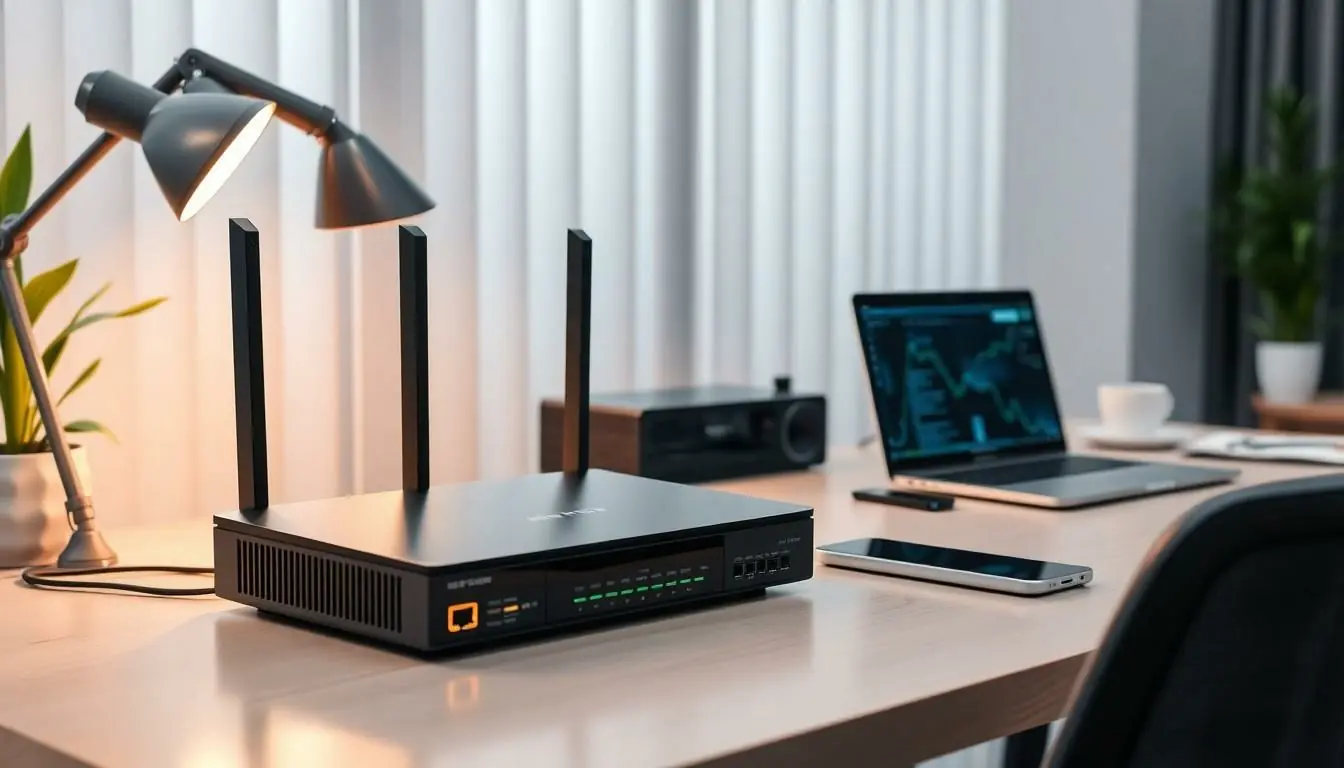Table of Contents
ToggleIn today’s world, a stable internet connection is as vital as coffee on a Monday morning. With everyone from kids streaming cartoons to adults working from home, home networking devices have become the unsung heroes of modern life. They keep the Wi-Fi flowing and the Netflix binge-watching uninterrupted, all while ensuring your online gaming sessions don’t turn into a pixelated nightmare.
Overview of Home Networking Devices
Home networking devices enable reliable internet connectivity across multiple devices within a household. Routers serve as the central hub, managing network traffic and ensuring data flows efficiently. They connect to modems, which link residential networks to internet service providers.
Access points expand Wi-Fi coverage, eliminating dead zones in larger homes. They connect to routers, allowing devices in different rooms to access the internet without interruptions. Powerline adapters utilize existing electrical wiring to extend connectivity into areas where Wi-Fi might struggle, delivering stable connections even at distance.
Network switches enhance the capability of wired networks. By adding multiple Ethernet ports, these devices connect various wired gadgets like printers and gaming consoles, supporting higher speeds compared to wireless connections. Ethernet cables are vital in these setups, often ensuring faster, more reliable data transfer.
Range extenders boost the existing wireless signal strength, accommodating users in high-demand environments. They repeat the Wi-Fi signal, enhancing coverage in challenging areas, such as basements or yards. Mesh Wi-Fi systems provide seamless coverage by using multiple nodes to blanket an entire area with a single network, minimizing dead zones significantly.
Smart home devices rely on a solid network foundation. Smart speakers, thermostats, and security cameras connect through the home network, enabling remote control and automation. Ensuring these devices communicate effectively requires robust home networking gear.
Home networking devices include routers, access points, switches, and range extenders, each playing a crucial role in creating a stable and efficient network.
Types of Home Networking Devices

Home networking devices play a vital role in establishing reliable internet connections. Several types cater to different needs for optimal performance.
Routers
Routers function as the central point of a home network. They manage data traffic between devices and connect to modems for internet access. Popular models support various Wi-Fi standards, including Wi-Fi 6, which provides faster speeds and better performance in crowded environments. Security features like firewalls and encryption ensure safe connections. Many routers also include built-in parental controls and guest network options, enhancing user experience.
Switches
Switches improve wired network efficiency. They connect multiple devices through Ethernet ports, enabling fast data transfer within local networks. Unmanaged switches offer plug-and-play functionality, suitable for simple setups. Managed switches provide additional control, allowing monitoring of traffic and configurations. Typically, a switch enhances both bandwidth and performance for devices like computers, gaming consoles, and printers that benefit from stable, wired connections.
Wireless Access Points
Wireless access points enhance Wi-Fi coverage in larger homes. These devices connect to the existing network infrastructure, extending signal range to eliminate dead spots. Deploying multiple access points results in a seamless network experience, allowing devices to roam freely. Compatibility with various Wi-Fi standards ensures high-speed connections for multiple users. They’re a key component for smart home integration, supporting gadgets requiring strong, stable connections.
Range Extenders
Range extenders amplify existing Wi-Fi signals. Placed strategically, they receive and rebroadcast wireless signals to improve coverage in hard-to-reach areas. Many extenders support dual-band functionality, allowing devices to connect to the most appropriate frequency for optimal performance. An easy setup process ensures quick deployment, expanding home network reach. Often used in multi-story homes, they provide consistent connectivity for streaming, gaming, and remote working needs.
Factors to Consider When Choosing Home Networking Devices
Choosing home networking devices involves several critical factors that impact overall performance and user experience. Users must assess specific needs to ensure effective connectivity.
Speed and Performance
Speed represents a vital aspect when selecting devices. Faster devices, particularly those supporting Wi-Fi 6, deliver improved data rates, enhancing activities like streaming and gaming. Performance metrics, including bandwidth and latency, directly affect internet usability. Throughput determines how much data can transfer simultaneously. Take note of the number of devices connected to the network, as this influences overall speed. For example, multiple users streaming content concurrently demand higher performance levels. Prioritizing devices with robust CPU and RAM will further enhance performance, providing seamless experiences.
Security Features
Security features are indispensable in maintaining a secure home network. Built-in firewalls and encryption protocols like WPA3 protect sensitive information from unauthorized access. Additional security elements, such as guest networks, can segregate visitor access from personal devices. Frequent firmware updates ensure vulnerabilities are addressed promptly. Protection against threats like malware or phishing attacks is crucial for safe browsing. Devices equipped with customizable security settings allow users to tailor protections per their requirements. Selecting options with comprehensive security features safeguards the integrity of the entire network.
Compatibility
Compatibility plays a significant role when integrating devices into existing networks. Ensuring that new devices work seamlessly with current hardware simplifies setup and improves functionality. Consider whether the device supports various applications and services, including smart home technologies. Additionally, backward compatibility with older standards maintains network continuity. Users should verify that devices connect using common protocols like Ethernet and Wi-Fi. Prioritizing mesh systems can facilitate better compatibility across different areas, offering smooth handoffs and unified coverage. Evaluating compatibility aspects helps achieve a cohesive and efficient networking environment.
Popular Home Networking Devices in 2023
Home networking devices continue to play a crucial role in maintaining strong and reliable internet connections. This section highlights the most popular devices in 2023.
Top Routers
High-performance routers dominate the market this year. Many leading models now support Wi-Fi 6 technology, which enhances speed and reduces latency. Devices like the ASUS RT-AX88U and NETGEAR Nighthawk AX12 offer advanced features such as multiple antennas, built-in security protocols, and robust parental controls. Using dual-band capabilities, these routers provide seamless connectivity for numerous devices simultaneously. Security features like WPA3 encryption protect sensitive data, ensuring safer browsing experiences.
Best Range Extenders
Effective range extenders eliminate dead zones in larger homes. Models such as the TP-Link RE650 and NETGEAR EX3700 stand out for their ability to amplify existing Wi-Fi signals efficiently. Each extender connects to a router and redistributes the signal, making it accessible in hard-to-reach areas. Ease of setup is a significant factor, with many models offering user-friendly mobile applications for quick configurations. Investing in a reliable range extender guarantees that all areas of the home receive robust internet coverage, enhancing overall user experience.
Home networking devices play a crucial role in ensuring a reliable internet experience in today’s connected world. With the right equipment users can enjoy seamless streaming gaming and remote work without interruptions.
Investing in high-performance routers access points and range extenders can significantly enhance network coverage and speed. By carefully considering factors like security compatibility and performance metrics users can create a robust home network tailored to their needs.
As technology continues to evolve staying informed about the latest devices and features will help maintain an efficient and secure home network for years to come.




